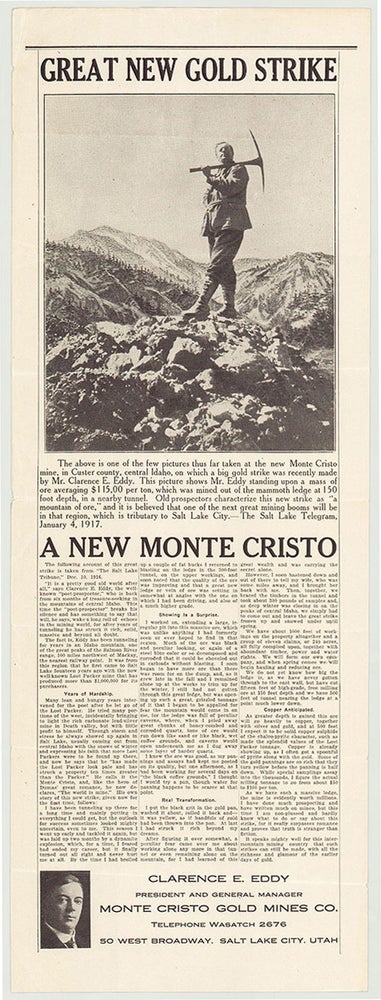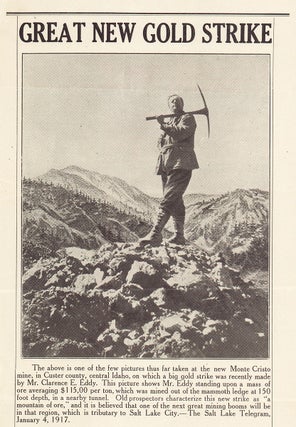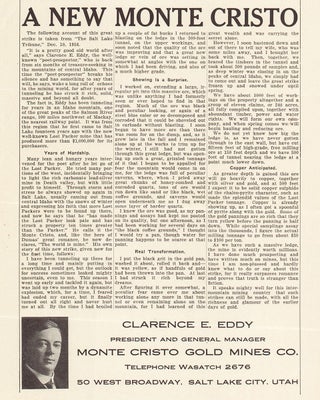Great New Gold Strike. A New Monte Cristo.
Salt Lake City, Utah: Monte Cristo Gold Mines Co., [1917]. llustrated Broadside, 22” x 8”, image size, 8” x 6.5”. A promotional broadside centering on “poet-prospector” Clarence E. Eddy’s evocative narrative of his discovery of a new mine in central Idaho, which he now announces to the public. Featured at the top is “one of the few pictures thus far taken at the new Monte Cristo mine” in Custer County, Idaho, where Eddy—identified here as President of Monte Cristo Gold Mines Co.—made a big gold strike. He is shown in a larger than life pose proudly standing atop a mass of ore with a mining pick on his shoulder. It is noted that this ore—mined out of a mammoth ledge at 150 ft. depth in a nearby tunnel—averages some $115,00 per ton. Text excerpted from The Salt Lake Telegram (of 4 January 1917) notes, “old prospectors characterize this new strike as ‘a mountain of ore,’ and it is believed that one of the next great mining booms will be in that region, which is tributary to Salt Lake City.” Additional text from The Salt Lake Tribune (of 10 Dec. 1916) consists of Eddy’s narrative of his mining adventures during a six-month “treasure-seeking” venture in the mountains of central Idaho. Eddy had come to Salt Lake City around the turn of the century with information on the Lost Parker mine, which produced more than one million dollars for its various purchasers. Following years of hardship after giving up control of the Lost Packer, Eddy here claims the new central Idaho property promises “ten times greater” than the Lost Packer. He calls it the Monte Cristo, and, like the hero of Dumas’ great romance, he now declares, ‘The world is mine.’” The bulk of the excerpted text is in Eddy’s own words—in which he graphically details his tunneling ventures in Idaho and his recent discovery:
When I pried away great chunks of honey-combed and corroded quartz, tons of ore would run down like sand or like black, wet coffee grounds, and caverns would open underneath me as I dug away some layer of harder quartz. I knew the ore was good […] I put the black grit in the gold pan, washed it about, rolled it back and—it was yellow, as if handfuls of gold had been thrown into the pan. At last I had struck it rich beyond my dreams.
After offering an account of his workings on the property, Eddy expresses his intention to begin hauling and reducing the discovered ore in the coming spring. He makes note of his anticipation of copper in the ore, which has already begun showing up, and he concludes his report by insisting the mine is “evidently worth millions.”
I have done much prospecting and have written much on mines, but this time I am non-plussed and hardly know what to do or say about this strike, for it really surpasses romance and proves that truth is stranger than fiction. It speaks mighty well for this inter-mountain mining country that such strikes can still be made, with all the richness and glamour of the earlier days of gold.
Provided at the bottom are Eddy’s Salt Lake City address and telephone number. Clarence Eddy (1874–1936) was born in Oregon and worked as a newspaper man in addition to laboring in Idaho’s mountains for years. In 1902, he published a collection of poetry and songs entitled The Pinnacle of Parnassus. Upon its publication, Challis Messenger called him “one of the promising young poets of the West.” No copies recorded in OCLC. A rare Idaho mining promotion broadside. CONDITION: A few tiny chips at margins, horizontal folds.
Item #5554
Price: $950.00




